Mana is the foundation for all forms of gameplay in Magic: The Gathering (MTG). Whether you’re playing with powerful mana rocks like Mox Ruby in Vintage, tapping a mana dork like Llanowar Elves in Modern, or searching for extra lands in Standard with a ramp spell like Cultivate, mana ramp is the method many decks use to get ahead of their competition.
While green has the most and best mana ramp options, and white gets mana ramp effects or land tutors periodically, colors like red have to get much more creative when looking for ways to add more mana to their mana pool.
While mana rocks can help fill this void, if you’re looking to tap red’s full mana ramping potential, you’re going to be leaning on its many options for mana acceleration.
How Does Red Mana Ramp Work in MTG?
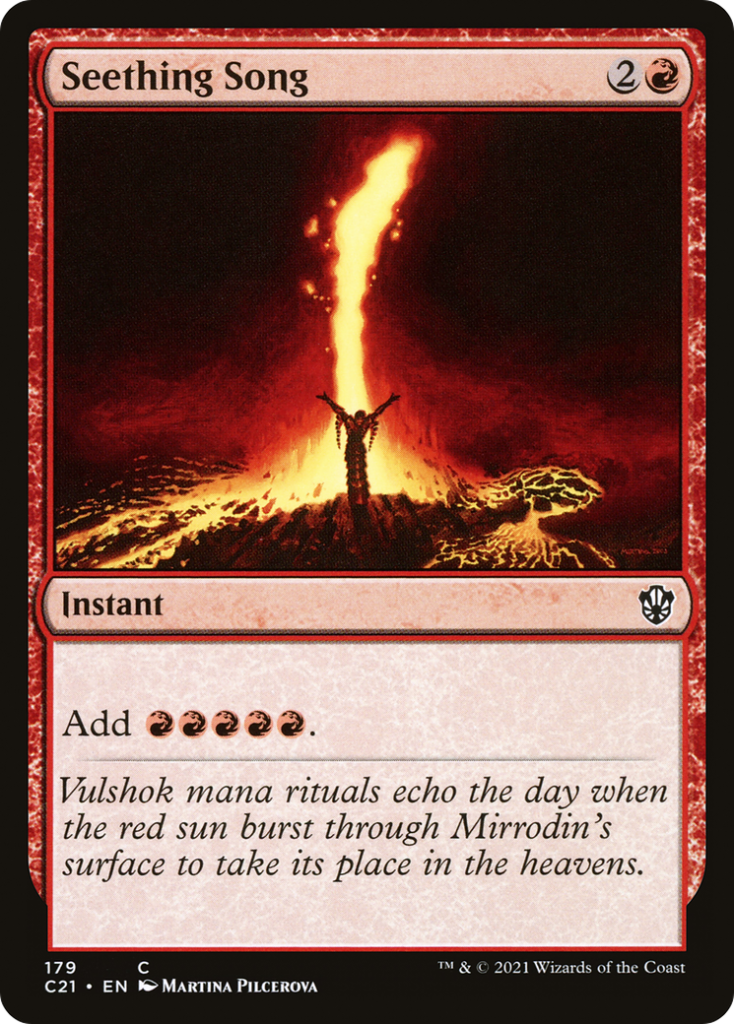
Red’s mana ramp options almost always come in the form of mana acceleration, or one-time increases in mana for your mana pool. While this differs from what people normally consider mana ramp, as your sources of increased mana aren’t permanent, mana acceleration often leads to much more explosive gameplay when used correctly.
Historically, red’s mana acceleration effects simply added an amount of mana to your mana pool, which you can then use to either fuel other mana accelerators to build up a Storm count, assemble a game-winning combo, or simply Fireball an opponent with lethal damage.
Nowadays, you’ll still find effects like these, but red’s mana acceleration has expanded to include the use of Treasures, which are artifact tokens you can tap and sacrifice to add a a mana of any color to your mana pool. You can either save these for use later in the game, or crack them immediately to fuel a big move that might not have otherwise been available to you on the same turn.
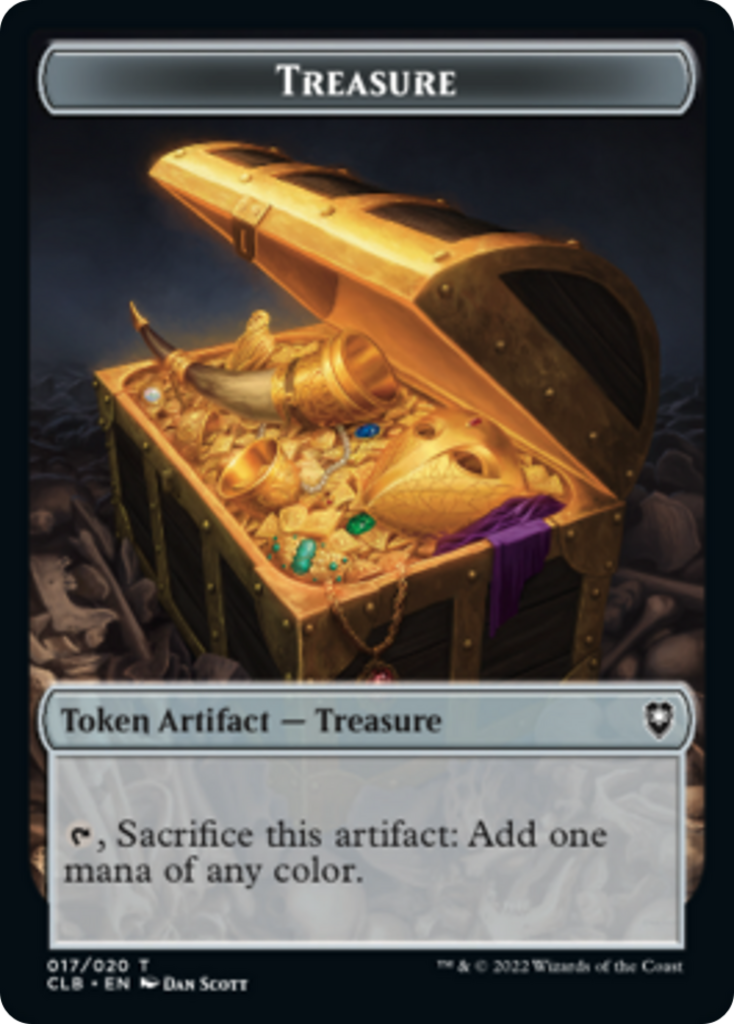
The flexibility of Treasure tokens has proven to be incredibly powerful since their premiere in 2017, and some have even wondered if the more powerful generators and support cards are too good.
While most tend to agree that we haven’t quite crossed that line, the impact that cards like Smothering Tithe and Dockside Extortionist have had on the Commander format is also undeniable.
This is especially impressive, as mana acceleration traditionally looks worse on paper than mana ramp. Given the choice of playing slightly more powerful cards for the rest of the game or making one extremely powerful move that can’t easily be repeated, most MTG players prefer the safer first route, as it’s easier to maintain gameplay tempo.
That said, underestimating the sheer mana output of some of red’s best mana accelerators can be a game ending mistake. Being able to turn 2 mana into 10 or 5 mana into 20 happens a lot in Commander, and when left unchecked, the resulting moves this much mana enables can be more than a table can bear at any stage of a game.
So which red mana acceleration cards are best suited to these explosive turns? Does red even have permanent mana ramp effects? Let’s take a look at the cards below to find out!
As with other MTG mana ramp articles, these cards are loosely ranked from worst to best. If a card does not appear on this list, but is a good fit for your deck, play it! The cards we’ll be looking at are good in a broad variety of decks, but do not represent an exclusive list of playable options in Commander.
Mana Flare
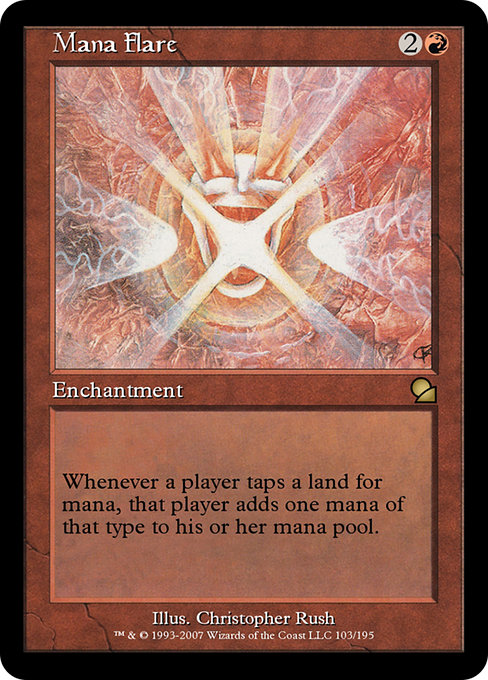
Commander games almost always devolve into shenanigans when an early Mana Flare hits the table. Doubling your available mana from lands for a mere 3 mana is incredibly strong, but is quickly balanced out by the fact that it doubles your opponents’ available mana too.
While this card is most commonly found in group hug decks (decks that are designed to enable everyone), decks that rely on big, splashy spells to win can also get a lot of mileage out of this card. In either scenario, timing is everything when it comes to playing this card since your opponents will usually get to take full advantage of its mana doubling before you do.
Hand it out too early, and an opponent might play a big creature like Terastodon that destroys your enchantment before you get a chance to use it. Play it too late, and you may miss your opportunity to win the game. You can sometimes prevent the former scenario with some table politics, but there’s always the chance someone is going to try and seize the opportunity to get ahead.
When playing a Mana Flare for my own benefit, I usually prefer to pair it with an extra turn effect or a splashy spell that gives me a lot of options like Time Stretch or Apex of Power. Something that will set me up to close the game or get really far ahead of the rest of the table.
Sure, this may mean my ramp spell sits in my hand until turn 6 or later, but if it means I don’t have to defend against a turn 5 Kozilek, Butcher of Truth or Omniscience, that’s a great trade as far as I’m concerned.
Mana Echoes
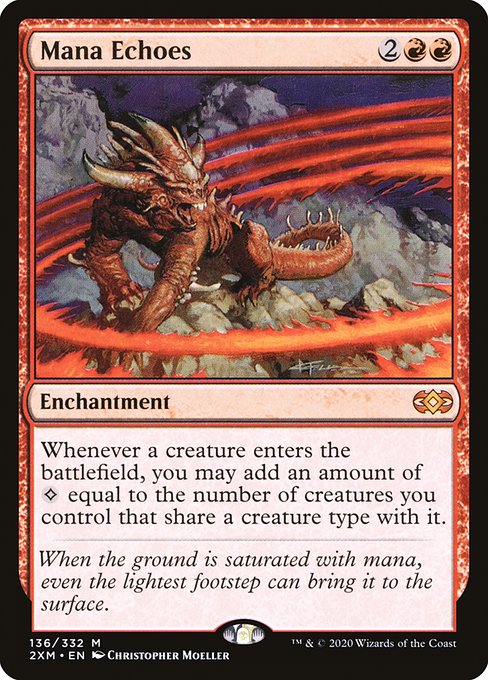
While Goblin decks have access to Brightstone Ritual and Skirk Prospector, and token decks or tribal builds that swarm the battlefield have access to Battle Hymn and Dragonrage, none hold a candle to the sheer mana production of Mana Echoes once it gets going.
Adding large quantities of colorless mana to your mana pool for each creature (including tokens) that enters the battlefield can enable some incredibly powerful shenanigans.
Creating infinite tokens with Sliver Queen or cards that produce tokens exclusively with colorless mana like Myr Matrix is the most common line of play, but the sheer amount of mana you get from tapping a commander like Krenko, Mob Boss can also let you spin up a lethal burn spell like Comet Storm with ease.
It’s also worth noting that you can also get access to lots of mana if your opponent plays a creature that shares a type with yours. Changelings like Masked Vandal or Taurean Mauler will be the most likely culprits for your unexpected windfall, but keeping an eye on all creatures that enter the battlefield can still pay off in big ways for the right battlefield.
Cleansing Wildfire and Geomancer’s Gambit
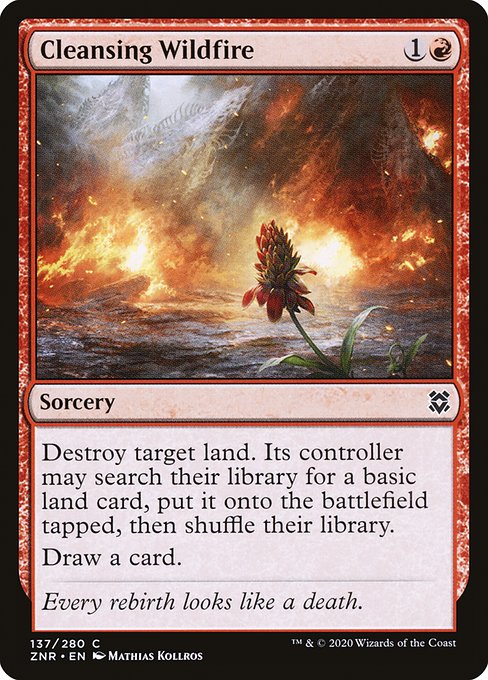
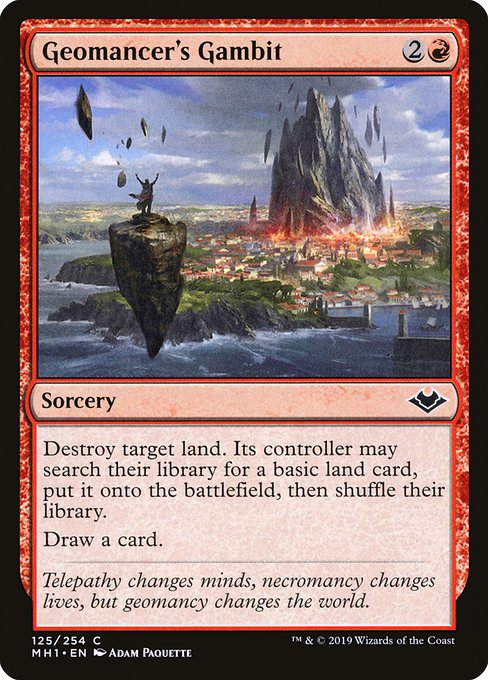
Cleansing Wildfire and Geomancer’s Gambit aren’t conventional ramp spells. Their intended design is to get rid of a problematic nonbasic land and force your opponent to replace it with a basic land. And they’re good spells for that purpose, especially since they both let your draw a card too.
Players of the all-common-card Pauper format are quite inventive though, and found a way to use these spells to break the color pie.
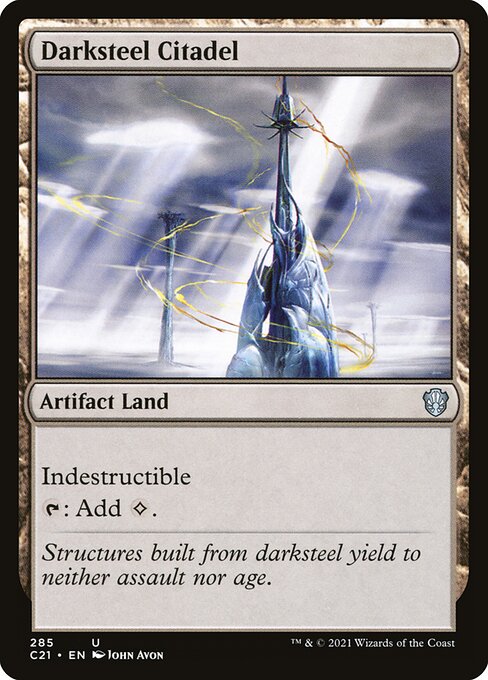
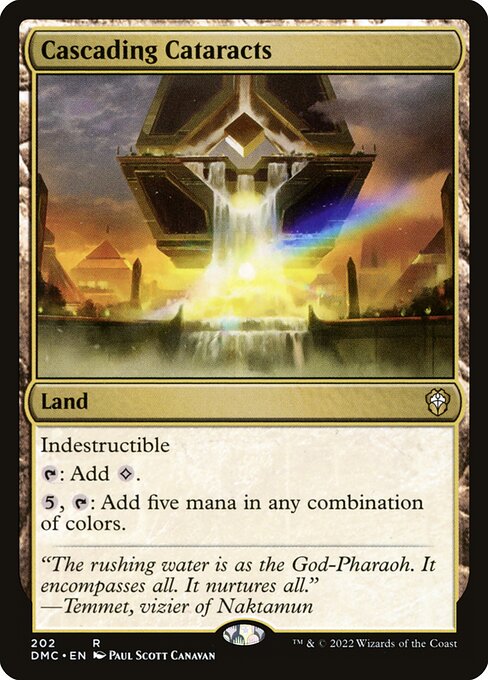
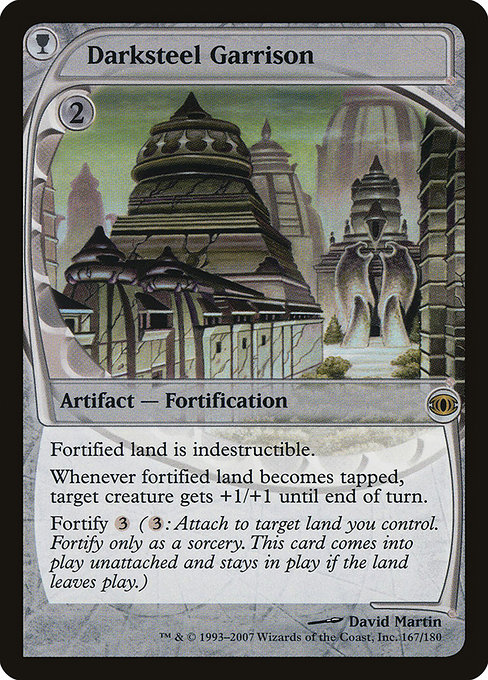
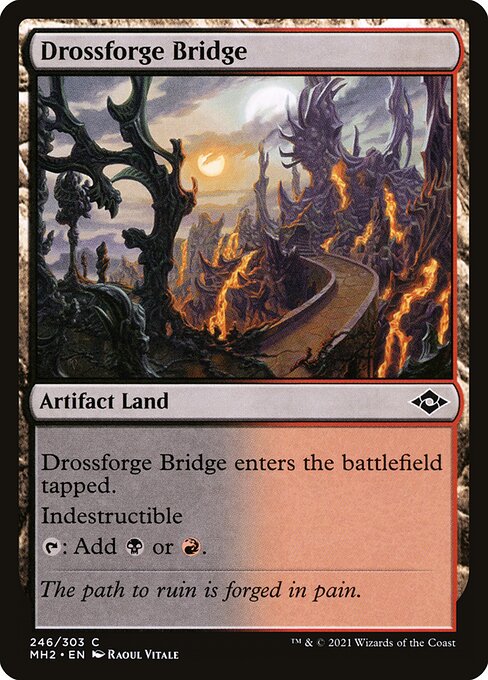
Since neither of these cards requires the targeted land to actually be destroyed for its controller to fetch a land, all you need to do is target an indestructible land on your battlefield, and your land destruction spell suddenly becomes a red ramp spell that draws you a card.
Very powerful if you’re able to pull it off early, and a cute value trick later in the game. Worst case scenario, you use these spells as intended to take out an opposing Gaea’s Cradle or Nykthos, Shrine to Nyx and draw a card, which is still well worth it.
Mono red decks will have a hard time setting up for this combo, as they don’t have reliable ways to find the pieces, but if you add blue or black, tutors like Trinket Mage and Vampiric Tutor can help you assemble the pieces without slowing you down, ensuring you are able to keep up with early mana rocks and ramp spells with ease.
Simian Spirit Guide
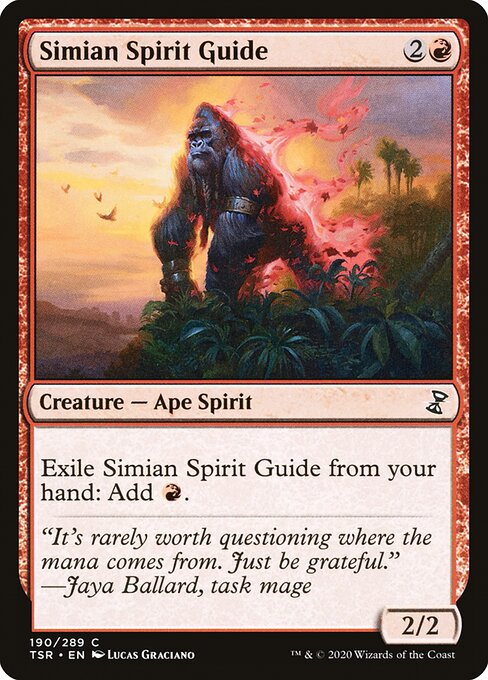
Simian Spirit Guide‘s power level tends to scale with how fast the decks in your Commander pod are. If you aren’t expecting big plays in the first few turns of the game, it’s probably not going to be all that helpful. If your decks try to play as quickly and efficiently as possible, like in cEDH, one extra red mana your opponents can’t see might change the entire course of a game.
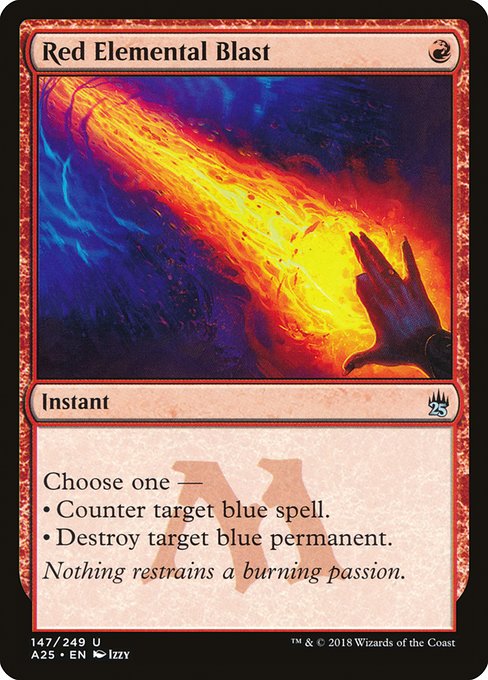
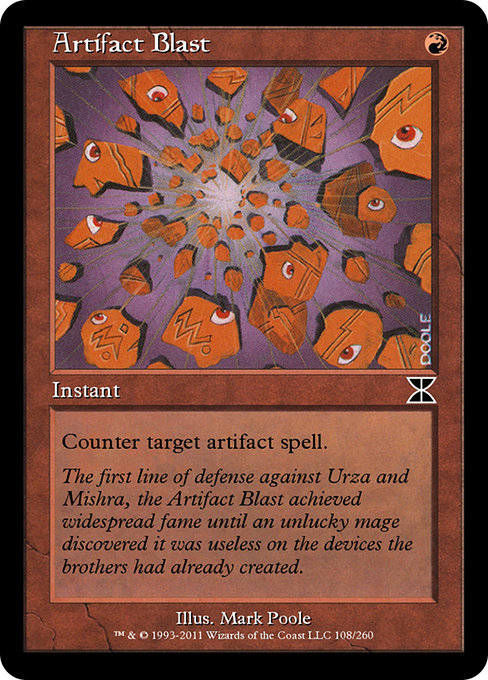
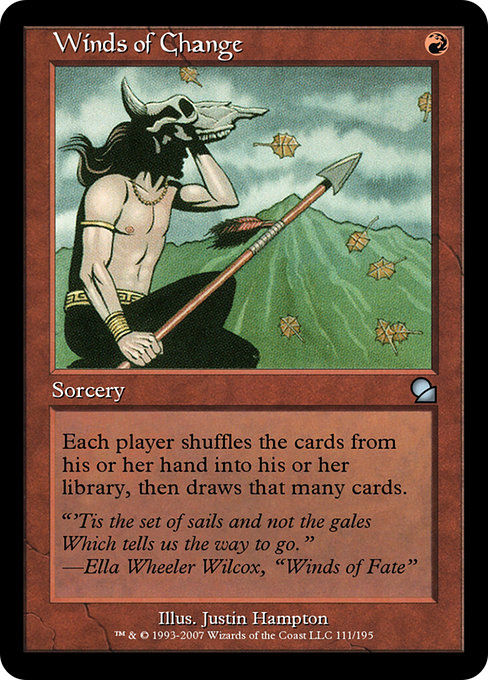

Even if you aren’t using it to fuel powerful 1-mana spells like Pyroblast or Winds of Change, Simian Spirit Guide also does a good impression of Lotus Petal, and can help you rush out cards like Dockside Extortionist or Underworld Breach to fuel bigger plays or simply combo off a turn ahead of schedule.
TL;DR – this monkey may not look like much, but a slight tempo boost at no cost is sometimes all you need to bury the competition.
Storm-Kiln Artist

Storm-Kiln Artist is a card I’ve seen steadily creeping into more Commander decks since its release in Strixhaven, and it makes a lot of sense. Creating treasure tokens simply by casting instants and sorceries is a different take on cost reduction, offering you a rebate instead of outright lowering the cost.
Your spells don’t even have to resolve to get the rebate! Just by even attempting to play the game, you’re rewarded with value.
Once your treasures are in hand, you can continue playing value spells on the same turn, save them up to respond to a threat and/or make a bigger play later on, or hoard them so you can attack someone with an unexpectedly powerful creature. Bonus points on that last one if you pair Storm-Kiln Artist with a Whispersilk Cloak or Rogue’s Passage.
All completely viable game plans, and the more I think about it, the more I realize that this card really showcases how dangerous a treasure producer’s flexibility is.
The only real drawback is that 4 mana is a steep asking price for a mana ramp effect. Well worth it if your deck thrives on instants and sorceries, but I wouldn’t call Storm-Kiln Artist an auto-include for every red deck. Where it shines, however, it really shines.
Treasonous Ogre
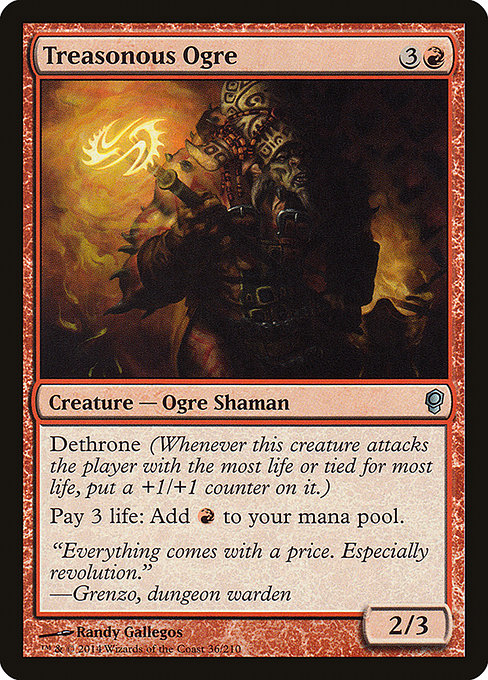
Treasonous Ogre, on the other hand, might be the single most dangerous 4-mana ramp spell ever printed. In a format where you start with 40 life, Treasonous Ogre can turn 4 mana into 12-13 red mana, which is more than enough to combo off against an unprepared table with Underworld Breach, Kiki-Jiki, Mirror Breaker, or Godo, Bandit Warlord.
While this combo-enabling means Treasonous Ogre is more commonly seen at cEDH tables, it can still do a lot of work in lower power games aiming to use this card fairly.
For example, if you’re able to keep Treasonous Ogre in play for a turn before using it early on, you can jump from 4 mana to 9-10 at the cost of roughly 15 life. This mitigates the “all or nothing” risk more commonly seen in cEDH games while still letting you rush out a couple modest threats or a huge powerhouse before your opponents are prepared to address them.
Sometimes, that will be enough to win the game outright. If you’re thwarted, you’ll still have roughly 20 life, which is a big enough buffer to keep you in the game and give you time to rebuild.
And if you do like taking risks, it’s worth remembering that winning the game at 1 life is the same as winning at 40. If you see an opportunity for Treasonous Ogre to win you the game, shoot your shot. If an opponent is trying to do the same, try to see what they’re aiming for, and time your disruption accordingly.
Birgi, God of Storytelling
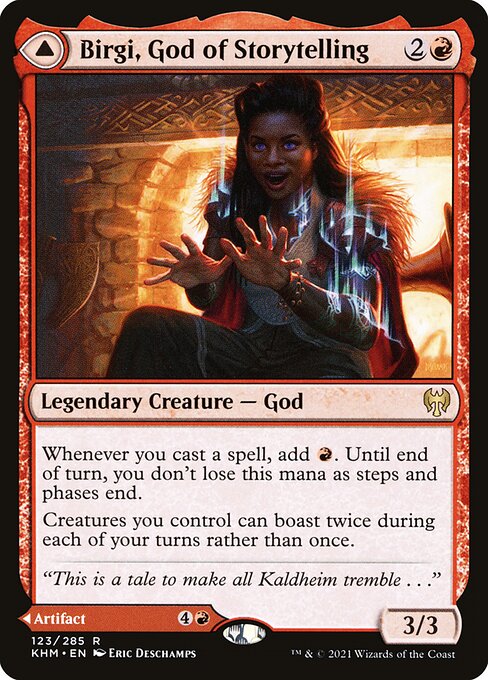
Birgi, God of Storytelling reminds me a lot of Storm-Kiln Artist, but this legendary creature just has so much more to offer. For starters, it can be your commander, ensuring you always have access to its mana rebate ability.
Second, the mana rebate works on all spells you cast, not just instants and sorceries. Sure, it only gives you red mana that you have to spend by the end of your turn, but if that means you can start chaining spells on turn 4 instead of turn 5, you’ll usually be very happy with that tradeoff.
Finally, if you have all the mana you need, Birgi’s a double-faced card, and its reverse side, Harnfel, Horn of Bounty, lets you dig for more cards to play from your deck at the cost of cards in your hand! This can get you out of some incredibly tight jams in the late game, and even turn things around if you’ve fallen behind the rest of the table.
Even if you’re just playing Birgi in the 99, this is an incredibly flexible suite of effects. And I guess you can use boast effects twice if you really want to, but the available pool of boast cards is small, underpowered, and sometimes doesn’t even get anything of consequence out of a second use.
Mana Geyser

I remember the first time Mana Geyser was played against me in a game of Commander. A buddy of mine played it against our pod late in a game that had reached a precarious balance, and the table’s reaction was some variation of “It does WHAT?!”. 21 mana later, that game wasn’t balanced anymore, and he was on the fast track to victory.
The key to Mana Geyser‘s power is that is counts the tapped lands each of your opponents control. Not the one with the most lands. Not those from a player of your choosing.
Every opponent.
5 mana so easily becomes 20+, and while it’s all red, that’s still usually enough to get really far ahead, assuming you don’t just win on the spot. All you have to do is wait for a moment where everyone’s spent their turn developing their board or playing powerful threats, play Mana Geyser, and watch your opponents realize they can do nothing but await the smiting that is surely coming down.
Admittedly, Treasonous Ogre is more powerful in many scenarios, especially in the early game, but Mana Geyser comes with no risks or strings attached. The raw one-time mana production it delivers is really only rivaled by Mana Echoes, which often requires having creatures in play to get going.
Since many low-power or non-cEDH optimized games frown upon optimized combo decks and often see higher turn counts, Mana Geyser is going to be the card you want during those games so you can guarantee the effectiveness of this ramp spell – no matter where you stand in terms of board state, creature count, or life total.
Jeska’s Will
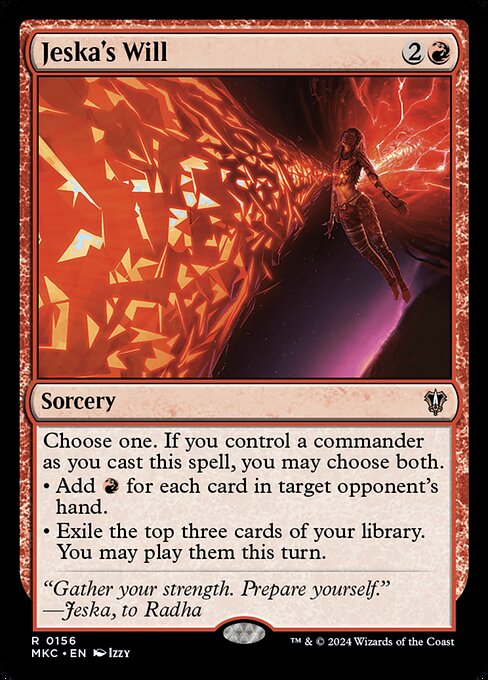
The first Commander Legends set brought us a lot of legendary creatures and cards specifically designed for the Commander format. Jeweled Lotus earned a lot of ire for looking like the most broken, uber-necessary mana accelerator for every Commander deck, but over time, most of us figured out the actual problem mana accelerator was Jeska’s Will.
For 3 mana, you get to do one of the following:
- Add a red mana to your mana pool for every card in an opponent’s hand
- Exile the top 3 cards of your library and gain the ability to play them during the same turn
- Do both of the above if your commander is in play
Powerful legendary creatures have become increasingly cost effective in recent years, so it is laughably easy to get both effects for 3 mana, which will usually net you 5-7 mana to play your newly accessible cards.
Each of these effects is well costed on its own, so even if you can only pick one, 5-7 mana will usually ramp out your commander or another expensive spell, and effectively drawing 3 cards will usually get you to a land drop or something you can play later in the game.
Most red decks are simply made better by playing Jeska’s Will – I genuinely don’t want to see another card at its power level anytime soon.
Dockside Extortionist

I’ve referenced Dockside Extortionist twice already, so it’s probably not a surprise I and many others consider it to be red’s best mana ramp card. 2 mana nets you a treasure token for every artifact and enchantment your opponents have on the battlefield, and since the effect is stapled to a creature, recursion and blink effects make its enter the battlefield trigger ripe for repetition.
Like Jeska’s Will, I’m of the opinion that a red deck is simply stronger when it is playing this card. You don’t need to put Dockside Extortionist in a Goblin deck, Pirate deck, Treasure deck, or any other specific strategy to take advantage of its ridiculously low mana cost to mileage ratio.
You simply let your opponents play Magic, and play it when you’re ready to make a big move. Early mana rocks often make it a solid turn 2 play, and if you don’t see it until turn 9 or 10, there’ll probably still be enough cards in play to net some solid value with your chump blocker.
Best of all, you don’t need to use those treasures right away. You can simply wait to crack them until after a Wheel of Fortune resolves or you draw that big X spell that could use a few extra mana to finish your opponents off.
Is Red’s Mana Acceleration Worth It?
Absolutely. If we were still in an era where Mana Flare and Mana Echoes were some of your best mana acceleration options for Commander, it’d be a different story, but many powerful card designs have come out in recent years. Heck, I play several of these red mana accelerators in decks with access to green’s powerful mana ramp options!
How many of these you play is going to depend on a few factors, including your deck’s strategy, colors, and budget. Ideally, you’d want to play both Jeska’s Will and Dockside Extortionist in most red decks, then add additional red mana ramp cards as needed, but neither card is particularly cheap, so you might have to find some other cost-effective options in the interim.
For those building a mono red deck, cards like Koth of the Hammer and Gauntlet of Might become much more attractive, as they provide a ton of mana in exchange for playing a lot of Mountains. For decks focused around treasure, you will probably go far beyond this list’s discussion to find as many efficient treasure producers as possible.
If I’m making it sound like red’s pool of mana ramp and acceleration options is deeper than it appears, that’s because it is. While the cards discussed here are going to have the broadest appeal for the widest variety of decks, picking what’s right for your needs is always going to be the best strategy.
So shuffle up, jam some games, and prepare to be surprised by what a “bad” mana ramping color is capable of.
Other MTG Articles You Might Enjoy
- MTG Green Ramp Cards for EDH
- MTG White Ramp Cards for EDH
- MTG Red Board Wipes for EDH
- Best Reanimator EDH Commanders
- Best MTG Token Deck Commanders
- Best Mana Rocks EDH
Braden is a founder of Assorted Meeples and has been a gamer & writer with a vivid imagination all his life. Don’t believe us? Check out his excitement when meeting Goosebumps author R.L. Stine as a kid! An avid Magic: The Gathering spellslinger for over 15 years, you can always convince him to shuffle up for a game (or three!) of Commander.
